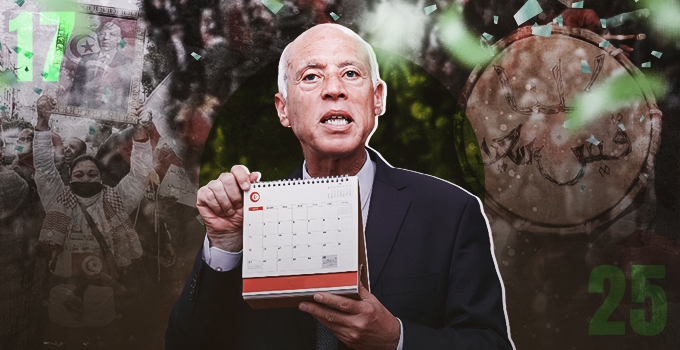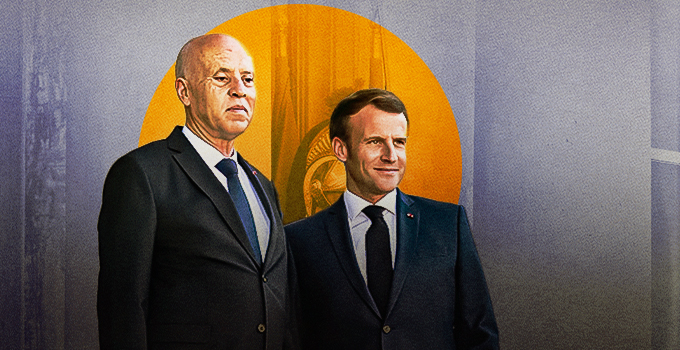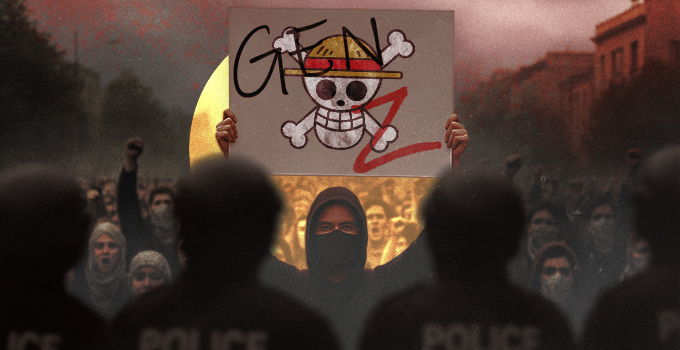This article reviews three possible regime scenarios for the three principle Maghreb countries of Morocco, Algeria, and Tunisia. The three scenarios include: the Islamization of the political sphere, the continuation of the authoritarian status quo, and accelerated evolution towards democracy.
Read the hole article here.[NDLR]
INTRODUCTION
Ever since the days of the Greek and Roman Empires, northwest Africa has been a well-defined region—geographically, demographically, culturally, and historically. The Muslim conquest in the late seventh century A.D., followed by the region’s complete Islamization and partial Arabization, inextricably linked the area to the East; but it did not erase its own particularity, even in the eyes of their now-fellow Muslims. [1] Just as the “Middle East” is a concept that was formulated by Europeans looking eastwards, the “Maghreb” (“West”) was a concept formulated by Muslims sitting at the center of the classical Islamic civilizations determining a definable “Other,” albeit an Islamic one. The French-colonial experience, which began in the 19th century, added an additional important layer to the Maghreb’s uniqueness. (Italy’s occupation of modern-day Libya is a separate story.) The Maghreb states, particularly the “core” countries of Morocco, Algeria, and Tunisia, currently face similar political, socio-economic, and cultural challenges:
- How are they to best supply the basic needs to their young and growing populations?
- How can the regimes reinforce their legitimacy after a half-century of independence; or, in the words of long-time Maghreb observer, I. William Zartman, how can they best achieve a “re-contracting” of the increasingly frayed social contract with their societies? [2]
- How should they approach their respective Islamist opposition movements?
- What is the best way of coping with the many challenges posed by the myriad processes of globalization?
In seeking to address these question, one can envision three different political scenarios during the next five years in Morocco, Algeria, and Tunisia: [3] (1) the continuation of the authoritarian status quo, whose legitimacy formula is based on a mix of state and Arab nationalism (the particular mix is different in each of the three countries); (2) the Islamization of the political sphere, with Islamist movements gaining increasingly central roles; and (3) an evolution towards a more genuine democratic system, in which the process of reform strengthens civil society and authentically democratic forces.
The background for this analysis is the United States’ Greater Middle East Initiative, a policy designed to address the root causes of Middle Eastern instability, violence, and anti-Western terrorism. Although the bulk of U.S. attention has been directed towards the eastern Asian portion of the Greater Middle East—Afghanistan, Iran, and Iraq—the issues at stake are no less relevant for Europe’s immediate neighbors just across the Mediterranean Sea and the Straits of Gibraltar. All of the dire circumstances confronting Middle Eastern states and societies—entrenched authoritarian regimes lacking popular legitimacy; strong Islamic opposition movements and smaller groups that engage in bin Laden-style terrorism; economic systems that have lagged far behind other regions in the increasingly globalized economy; large youthful populations clamoring for jobs or visas to the West, resulting in migration and social pressures on European countries—are present in varying degrees in the Maghreb. At the same time, their civil societies contain the potential for vibrancy, being shaped by numerous cross-cultural currents emanating from Berber, Arab-Muslim, African, and European heritages, the ever-expanding links with Europe, and, increasingly, with the rest of the developed world. Indeed, Maghrebi political and social systems appear more ripe than those in the Arab and Muslim East for the kind of partnership initiatives envisaged by Western policy-makers, which they hope will be transformative in nature.
To be sure, Maghreb states differ widely from one another, both in their historical evolution and in their current realities. Classifying them according to the degree of political pluralism in each country finds that Morocco is at the top, Algeria a close second, and Tunisia lagging far behind. A somewhat different order of ranking results if one examines the degree of societal acceptance of regime policies towards liberalization. In Morocco, there is a fair degree of acceptance regarding the pace of liberalization, and disagreements are expressed largely within a consensus over the rules of the political game. Broad sections of Tunisian society appear to accept with understanding the utter lack of progress towards greater political pluralism. In Algeria, on the other hand, the differences between the regime and various sectors of society (secular and Islamist opposition groups, and activists among the Kabylian-Berber community) regarding the pace of liberalization are a continuing source of tension. Practically speaking, the “King’s dilemma” first formulated 30 years ago by Samuel Huntington, in which autocratic rulers may undermine their basis of power by adopting reforms, but may risk the same result if they do not do so, remains in force in the Maghreb. [4]
TUNISIA [5]
Tunisia poses a bit of a paradox among Arab states. On the one hand, it has been consistently pro-Western since achieving independence in 1956. It has a history of vibrant civil society institutions, including labor movements, political parties, and women’s groups. Its secular ethos was highlighted by the fact that women’s rights have been enshrined in Tunisian law from the outset (e.g., it is the only Arab state in which polygamy is officially outlawed). [6] Likewise, populist-statist economic policies were abandoned in recent decades in favor of liberalization and privatization—policies generally deemed favorable for the development of political pluralism. It is a relatively prosperous state, with a per capita GDP of $7,600, high rates of literacy and education, and a significant middle class; and the state itself possesses a high degree of social cohesiveness and historical specificity. On the other hand, Tunisia is currently among the most authoritarian of Arab states, having severely repressed all manifestations of political opposition and independent civil society—whether secular-liberal or Islamic—in the last fifteen years. This has been accompanied by the development of a personality cult around President Zine Abidine Ben Ali.
Scenario I: Continuation of the Authoritarian Status Quo
This is by far the most likely of the three scenarios under consideration. After a brief initial period of political liberalization, reconciliation with long-time political opponents, and the extension of legal public space to the Islamist movement, Ben Ali reinstituted a repressive single-party rule in the early 1990s. He then undertook a series of measures to bolster and consolidate his preeminence, while emasculating all sources of opposition. Moreover, to the surprise of democratic transition theorists, policies of economic liberalization in the 1980s and 1990s did not result in the creation of power centers in possession of a greater degree of autonomy and an increased will to challenge the political status quo. Nor were the downtrodden rural populations empowered by the privatization of the agricultural sector. Rather, these new policies actually tended to strengthen corporatist clientelist and neo-traditional patterns of social and political organization, and the repression of existing civil society groups. [7] The business sector and the security services constitute the pillars of the regime, while legal political parties have scant financial resources or public following and are dependent on the government’s goodwill for their continued existence. As a result, Tunisia remains one of the world’s oldest authoritarian one-party regimes, with a deadened public sphere, dismal human rights record, and sham electoral process that has essentially made Ben Ali “President for Life.” [8]
The background for Ben Ali’s repressive regime is two-fold: the success of the Islamist al-Nahda party in the relatively free parliamentary elections in 1989, and the horrific violence in neighboring Algeria during the 1990s. Hence, the Tunisian elites and middle class alike, fearful of the consequences of a rising political Islam in a society noted for its relatively liberal and secular ambience, essentially agreed to their indefinite political emasculation in return for the regime’s repression of the Islamist movement and the maintenance of a liberal economy and the existing legal and social frameworks.
To be sure, Tunisia has come under harsh criticism by Western governments and NGOs for its human rights record and repression of journalists. [9] The Ben Ali regime’s blunt rejection of even modest, incremental political reform has also embarrassed Washington, for it directly clashes with its proclaimed strategic goal of promoting democratization in the Middle East. Yet for now, Tunisian society’s quiescence testifies to the regime’s successful efforts against radical Islam. With more important fish to fry, it is likely that Washington will occasionally continue to rap the regime on the knuckles for failing to promote political reform while welcoming its cooperation in the war on terror, maintaining stability at home, and advancing women’s rights. France, Tunisia’s former colonial overlord and main trading partner, is even less likely to be troubled by the continuation of the status quo, so long as the regime remains stable and demonstrates cooperation in fighting the tide of potential migrants seeking to enter fortress Europe.
Scenario 2: The Islamization of the Political Sphere
No organized Islamist opposition operates above ground in Tunisia, although one can safely assume that the Islamist current continues to attract sympathizers, particularly those from the lower socio-economic stratum. The terrorist bombing of the Jerba synagogue in 2002 demonstrated the recruiting abilities of jihadi Islam.
The al-Nahda movement was severely repressed, and its main figures are either abroad or in jail. Hence, its political potential appears extremely limited. Interestingly, the movement has shown signs of evolution of its thinking towards the acceptance of a multi-party political system that would include secular parties and movements. To that end, it has begun to cooperate with secular opposition forces in their common Parisian exile. Whether or not there has been a strategic shift in al-Nahda’s thinking, or whether its actions can be best understood on the instrumental, tactical level, remains to be seen.
Scenario 3: Accelerated Evolution towards Democracy
Western interest in seeing at least the beginning of a process of political evolution in Tunisia may eventually bear some fruit in the coming years. However, with the Tunisian secular opposition as emasculated as the Islamists, there is neither no one individual, nor any issue, that appears capable of galvanizing a process of genuine democratic reform. Nonetheless, one can assume that the discourse of reform, as voiced both in the West and within liberal circles in the Arab world, is being heard in Tunisia as well. [10] Apparently, the Ben Ali regime will have to either feel sufficiently threatened by continued stagnation, or sufficiently confident in its ability to control the pace of change before it allows such a process to get underway. For the time being, neither appears to be on the horizon. In the event of Ben Ali’s incapacitation, one can envisage his successor initially adopting liberalization measures similar to the ones he himself embraced when he replaced Habib Bourguiba in 1987, in order to legitimize his rule.
CONCLUSION
Whereas the regime in Tunisia is still not prepared to countenance significant measures of political liberalization, the regimes in Morocco and Algeria are busy— each in its own style—seeking policy modifications that will enable them to style—seeking policy modifications that will enable them to successfully cope with the various challenges posed by their societies. The axis of confrontation between the Islamic movements and the political establishments of each of the three countries grabs most of the attention of observers. Nonetheless there exist other civil society forces, among them Berbers, women, portions of the middle class, human rights organizations, and segments of the younger generation who constitute significant pieces of the North African mosaic. The processes of building modern civil societies are exhausting, Sisyphean, and frustrating. The extent of the regimes’ abilities to cope with the demands of these forces, and the wisdom they exercise in doing so will help determine the course of political and social life in the Maghreb in the coming years.
Source: The Middle East Review of International Affairs (MERIA)
[1] L. Carl Brown, “Maghrib Historiography: The Unit of Analysis Problem,” in Michel Le Gall and Kenneth Perkins (eds.), The Maghrib in Question (Austin, TX: The University of Texas Press, 1997), pp. 4-16.
[2] I. William Zartman, “Introduction: Rewriting the Future in the Maghrib,” in Azzedine Layachi (ed.), Economic Crisis and Political Change in North Africa (Westport, CT and London: Praeger, 1998), pp. 1-5.
[3] Morocco’s and Algeria’s combined population of over 60 million persons constitutes 75 percent of the five-nation Arab Maghreb Union. Tunisia’s population adds an additional ten million persons to the figure. The Arab Maghreb Union consists of Morocco, Algeria, Tunisia, Libya, and Mauritania. Founded in 1989 with great fanfare, amidst expressed hopes for establishing closer regional ties and a regional economic bloc, it has utterly foundered, primarily on the shoals of continuing Algerian-Moroccan differences over the future of the Western Sahara and on Algeria’s implosion during the 1990s.
[4] Samuel P. Huntington, Political Order in Changing Societies (New Haven, CT: Yale UP, 1968), pp. 177-91.
[5] This section has benefited considerably from Michele Penner Angrist, “Whither the Ben Ali Regime in Tunisia,” in Maddy-Weitzman and Zisenwine (eds.), The Maghreb in the New Century.
[6] Laurie A. Brand, Women, the State and Political Liberalization (NY: Columbia UP, 1998); Mounira M. Charrad, States and Women’s Rights: The Making of Post-Colonial Tunisia, Algeria and Morocco (Berkeley: University of California Press, 2001).
[7] Stephen J. King in Liberalization against Democracy: The Local Politics of Economic Reform in Tunisia (Bloomington and Indianapolis: Indiana University Press, 2003).
[8] Neila Charchour Hachicha: “Tunisia’s Election Was Undemocratic at All Levels,” Middle East Quarterly (Summer 2005), http://www.meforum.org/article/732.
[9] “Tunisia,” Country Reports on Human Rights Practices – 2005, Released by the Bureau of Democracy, Human Rights, and Labor, March 8, 2006, http://www.state.gov/g/drl/rls/hrrpt/2005/61700.htm; “IFJ Condemns Intimidation as Tunisian Journalists Plan National Union Congress,” August 24, 2005, http://www.ifj.org/default.asp?index=3328&Language=EN; “Tunisian Commitments Unfulfilled Following WSIS II,” International Freedom of Expression Exchange Clearing House (Toronto) PRESS RELEASE, April 26, 2006, Posted to the web April 27, 2006, http://allafrica.com/stories/200604270343.html
[10] Barry Rubin, The Long War for Freedom (Hoboken, NJ: John Wiley & Sons, 2006), pp. 112-14.




wanting quran and islamic arabic literacy/things for free and sent to to 44 newcastle avenue,hainault,essex,IG6 3EE. Thank you. zuber ahmed yahoo@yahoo.co.uk